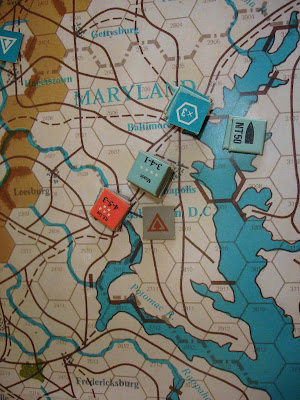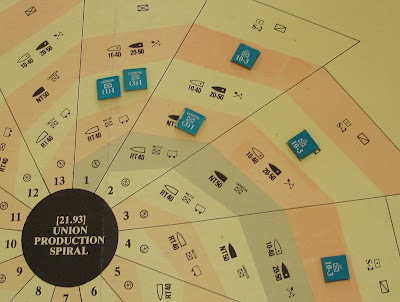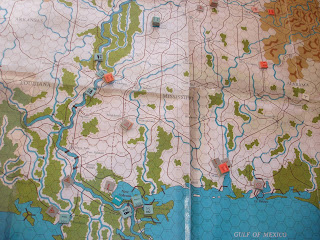In addition to reading Volume One of Bruce Catton's ACW opus (which gave me a good feel for the causes of the war), as we played War Between The States I read this book: 1400 Days by Chris Bishop, Ian Drury and Tony Gibbons.
It made great companion reading, although our game didn't reflect history much (that might be different when I get into the game with Vassal using the latest rules).
The illustrations are excellent and the day by day account gives a good pace and also provides some wider context (as does the introduction and the end piece).
I know I bought my copy cheap, years ago. I now know why. It is missing pages 161 to 176. This means it skips from 25 November 1863 to 24 March 1864. Boo!
Next up is to read Terrible Swift Sword, Volume 2 of Bruce Catton's trilogy.
Sunday, July 30, 2017
Thursday, July 27, 2017
Athenians versus Thessalians
Just time for a DBA 3.0 game last night. Stephen took some of my Greeks to make an Athenian army and I took some to make a Thessalian army.
I was the defender and went for some nice ploughed fields.
My first PIP roll of a one meant those fields were rough terrain.
Action quickly developed on my right.
And on my left.
It was a bit back and forth
As the main battle line of the Athenians started to close,
my forces on the flanks started to make progress.
And when the clash of spears commenced,
although pushed back, the Thessalian line held.
The Athenian wings had however crumpled.
This was only my third DBA 3.0 game and I'm still coming to grips with them. Some of my rule adjudications possibly reverted to DBA 2.2 due to the excitement of this simple, little but very elegant game.
Dunkirk
This is a good movie. I liked how it was set in three parts: in the air, on the land and in the sea. Once I twigged to it I also enjoyed how the three parts were interlinked and backtracked.
The initial scene and how the gun fire turned into the film score I found annoying, but it ceased to be noticeable after this. I think I'd been listening out for the high pitch of the German machine gun which is quite different to the drum/bass line that eventuated.
The story was secondary to the visuals, but the cinematography built structure with the interleaving of the air, land and sea. Occasionally this was let down by positioning of the vessels and men close and then distant, but this would also be part of the backtracking of the time lines.
The air segments were the best. The naval segments impressive and the land, with its large crowds, was seamless.
This was not a movie about the battle, but about the rescue. No heroes, just people doing their duty. No glory, just plenty of the horror of war. It might not have been intentional, but by the end all the soldiers started to look the same, further emphasising the absence of glory and heroes.
The initial scene and how the gun fire turned into the film score I found annoying, but it ceased to be noticeable after this. I think I'd been listening out for the high pitch of the German machine gun which is quite different to the drum/bass line that eventuated.
The story was secondary to the visuals, but the cinematography built structure with the interleaving of the air, land and sea. Occasionally this was let down by positioning of the vessels and men close and then distant, but this would also be part of the backtracking of the time lines.
The air segments were the best. The naval segments impressive and the land, with its large crowds, was seamless.
This was not a movie about the battle, but about the rescue. No heroes, just people doing their duty. No glory, just plenty of the horror of war. It might not have been intentional, but by the end all the soldiers started to look the same, further emphasising the absence of glory and heroes.
Zulu Dawn
Some one left this at the club and I took it for safe keeping. I thought I better watch it. Impressive.
The colonial period is not one I know a lot about, but I can certainly see the attraction.
The colonial period is not one I know a lot about, but I can certainly see the attraction.
"Behind you!"
Saturday, July 22, 2017
GDW - World War Three - Game Turn Three
The war enters its third week...
The Norwegian Front. Narvik is under intense attack.
The North German plain.
Holland is demoralised and Belgium shaken.
NATO is desperately trying to hold the Ruhr cities.
Central Germany.
The Warsaw Pact forces are across the Rhine.
Only newly arrived Spanish troops block their way to France.
Understandably France is shaken.
Austria entered the war, but was immediately invaded.
The Italians are now moving up.
The Soviet invasion of Austria brought Yugoslavia into the war on NATO's side.
But the Reds were ready ...
After a prolonged battle, the Warsaw Pact has captured Istanbul.
In the eastern half of Turkey things are moving slowly,
but Turkey is being crushed.
Down in Iran the US have invested Esfahan.
About now I think the US President would be unlocking the briefcase containing the launch codes.
Making Ligny Brook
After our relatively impromptu game based on the Battle of Ligny on 17 June this year, I was keen to replay it (as we ran out of time in the first game, plus I have all the figures needed so it is ready to go, figure wise at least). It was just a matter of having the terrain (or borrowing the clubs). As I am in need of terrain I set about making enough stream sections for this battle field, having many years earlier created a sample.
First challenge was settling on a map of the battlefield. There are so many. And all different (mostly). I ended up using one I couldn't see very well due to its mass of detail and fine print, but I had back up by using the trusty SPI board game of Ligny from Napoleon's Last Battles and a few other maps. The map I used is the Rousseau Map of the Battle of Ligny (1853), which can be found here.
First challenge was settling on a map of the battlefield. There are so many. And all different (mostly). I ended up using one I couldn't see very well due to its mass of detail and fine print, but I had back up by using the trusty SPI board game of Ligny from Napoleon's Last Battles and a few other maps. The map I used is the Rousseau Map of the Battle of Ligny (1853), which can be found here.
My model Ligny battlefield so far:
I still have to perfect the BUAs and make at least two hills,
plus there will be some small woods. Not sure about roads.
The BUA boundary pieces removed for a better natural shot.
Looking from the east, with the village of Ligny front centre.
Bird's eye
The view from the western edge
The making of Ligny Brook
Strips of felt cut to size using sharp scissors.
PVA glue was run down one side at a time and then the result pushed in a tray of sand.
With patience this technique produced as decent bank for my stream (mostly).
While the sand glue mixture was easy to paint (once it had dried), not so the felt.
So I ended up using a white undercoat.
This produced an interesting effect, but I wanted muddy water.
So on went a pale brown shade.
The banks were also given various coats of paint, from a black, to a dark brown
and then light browns dry brushed.
The water sections were given two coats of gloss varnish.
Then the banks were flocked.
This step proved to be the trickiest, in part because my first attempt was rushed.
My guess was that there was enough unpainted felt around that absorbed the watered down PVA glue by the time I came to apply the flock. Doing just a few inches at a time over came this problem, but meant this final step took the longest time.
This was an early shot and I like how the light has reflected on the varnish.
It was raining outside and I could well imagine the rush of water in the Ligny Brook.
Wednesday, July 19, 2017
War Between The States - Games Turns 137 to 138
Well, strategic cycle 2/64 got off to a good start with the reduction of the fortress protecting New Orleans.
More garrison units built.
Same for the Confederates.
Well, Meade tried, but failed to dislodge Lee.
Lee successfully stormed Washington.
Game Over.
Pity, as Sherman had just about made it to Yazoo City.
For the last two turns the initiative chits for the Union had been 2, 2 against a steady 3 for the Confederates. Not getting the 4 chit meant Meade lost a chance to attack before Lee was reinforced. Once Lee had taken the fortress, nothing was going to shift him, or the massive 50 political points he received. Losses were 10 for the Union and 14 for the Confederates.
Lots to think about. I hadn't used the Union navy to help with defence or attack and that might have cost me a bit. Anyway, now to look at the 2016 rules and the Vassal module.
Tuesday, July 18, 2017
War Between The States - Games Turns 129 to 136
The war continues with excitement and perhaps decisive action in the west.
Union production for the 13/63 cycle was to augment a 3-3 infantry division to a 10-3
and with the remaining 3 personnel points build a 3-1 garrison.
The Confederates built a 10-1 garrison.
Under their special replacement rule this can add to their infantry divisions in the field.
The turn starts well for the Union when Burnside throws off the forces besieging him at Fort Monroe.
It then goes bad when the rebels besiege Washington.
In the previously exciting Eastern Theatre,
nothing much is happening.
Sherman has his eyes on Nashville and the Confederates have their eyes on Memphis.
Meade saves Washington,
but now Baltimore is threatened.
After a brief move towards Nashville,
Sherman pulls back to Memphis.
The East Coast is unchanged.
If anything The Union are asking why they bothered.
The Confederates have an abundance of supplies.
Plus they are not having to spend resources when they add garrison factors to their infantry divisions.
Down in the Gulf, the siege of New Orleans continues.
The situation in the East has stabilised.
For the 13/63 cycle the initiative chits for the Union had been 4, 1, 1, 4 against a steady 3 for the Confederates. Losses were 16 for the Union and 7 for the Confederates.
Union is reduced to building garrisons.
As is the Confederates.
But as noted, they can convert their garrisons troops to regular infantry,
without cost.
This effectively means they have double the manpower.
Lee strikes at Baltimore.
Meade rescues Baltimore (on his third attempt I should say),
only to see Washington besieged again.
The Confederates are able to bring reinforcements (i.e. their freshly built garrison troops)
north to replenish Lee's losses as he attempts to storm the fortress guarding Washington.
The Confederates ports have been reduced to three,
but it has negligible impact on their resources.
Schofield has taken Brashear for the Union,
another port, but one that was isolated since the siege of New Orleans.
A siege that is now in it's fourth month.
Sherman is on the move.
For the 1/64 cycle the initiative chits for the Union had been 2, 4, 4, 2 against a steady 3 for the Confederates. Losses were 28 for the Union and a staggering 51 for the Confederates. Trying to storm fortifications is a costly business.
The critical thing with the Confederates threatening Washington and or Baltimore is that they gain a political point each cycle for it. With the slow progress of the siege of New Orleans, it is looking very grim for the Union.
Subscribe to:
Posts (Atom)


















































